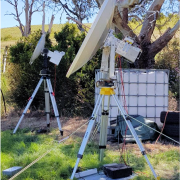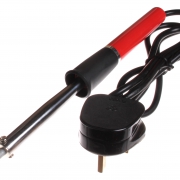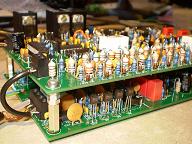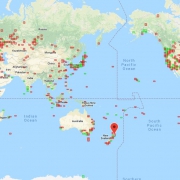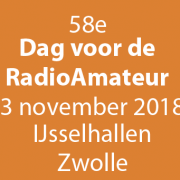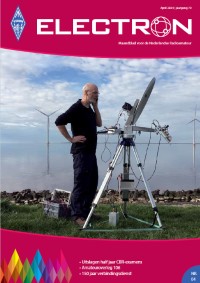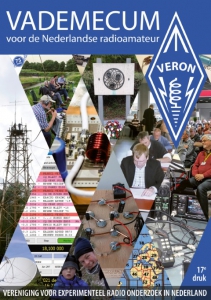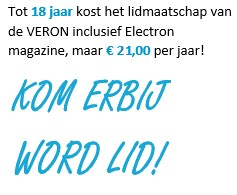Het ontwerpboek voor de radio hobbyist
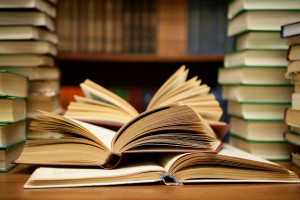 Het is de donkerste periode van het jaar. De radio hobbyist trekt zich dan terug in de shack. Immers, buiten aan de antenne’s sleutelen is geen pretje. Dan beter binnen met de voeten op de warme lineaire eindversterker. Zoals altijd met de soldeerbout binnen handbereik. En ook met een gefronste blik op oneindig over wat nu weer eens in elkaar te gaan knutselen.
Het is de donkerste periode van het jaar. De radio hobbyist trekt zich dan terug in de shack. Immers, buiten aan de antenne’s sleutelen is geen pretje. Dan beter binnen met de voeten op de warme lineaire eindversterker. Zoals altijd met de soldeerbout binnen handbereik. En ook met een gefronste blik op oneindig over wat nu weer eens in elkaar te gaan knutselen.
Dan helpt een goed boek. En dan hoeft dat niet noodzakelijk gloednieuw te zijn. Maar wel van een gerenommeerd radioamateur. En ook bomvol ontwerpen die goed reproduceerbaar zijn. Met de nodige uitleg en zonder al te moeilijke theorie. Gelukkig ook nog eens gratis als verzameling PDF’s te downloaden. Dus, wat wil je nog meer?
The Radio Hobbyist’s Designbook
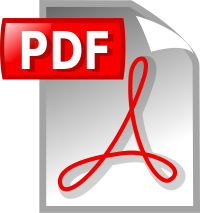 Onze leestip is het “Radio Hobbyist’s Designbook” geschreven door Leonard H. Anderson (K6LHA). Dat boekwerk is beschikbaar als PDF vanaf de website van Hans Summers (G0UPL). Maar dan wel in vijf delen te downloaden. Het is zo geschreven dat het je ook helpt bij het ontwerpen van radio-gerelateerde elektronica. De auteur gaat er dan wel van uit dat je wat weet van elektronica. Maar hoofdstukken over reeds bekende materie kun je dan ook probleemloos overslaan. Daarbij beperkt de benodigde wiskunde zich tot wat algebra en trigonometrie. Zo behandeld hij het spectrum van DC tot en met VHF.
Onze leestip is het “Radio Hobbyist’s Designbook” geschreven door Leonard H. Anderson (K6LHA). Dat boekwerk is beschikbaar als PDF vanaf de website van Hans Summers (G0UPL). Maar dan wel in vijf delen te downloaden. Het is zo geschreven dat het je ook helpt bij het ontwerpen van radio-gerelateerde elektronica. De auteur gaat er dan wel van uit dat je wat weet van elektronica. Maar hoofdstukken over reeds bekende materie kun je dan ook probleemloos overslaan. Daarbij beperkt de benodigde wiskunde zich tot wat algebra en trigonometrie. Zo behandeld hij het spectrum van DC tot en met VHF.
Dit boek is een goede referentie voor de radiohobby. Als een persoonlijke gids bij ontwerp doelstellingen. Daarom is het geschreven in een soort van “Reader’s Digest” format. Met andere woorden, beknopt en doelgericht. De onderwerpen met zo min mogelijk woorden toch goed behandeld. Hieronder is de (Engelstalige) hoofdstuk indeling te vinden. Dan is in één oogopslag te zien wat je er wijzer van kunt worden.
Radio Hobbyist Ontwerpboek Inhoudsopgave
BASICS
- Title page, dedication, brief history of origin, Table of Contents
- Bare bones of what is needed to do design at home, a common-sense approach.
- Mathematics needed in design, often-used constants; Greek letter common use.
- Waveforms, Heterodyning, Mixing; with easier form of mixings’ spurious products.
- Bandwidth, Modulation, Noise; Shannon’s Law, John Carson’s original formulas for basic modulation to get AM-FM-PM, Noise sources.
PASSIVES
- Basic sources, E-I-R, DC laws; a review of basic DC with Kirkhoff’s Laws.
- Passive R-L-C Components; a quick look at AC Laws and basic components.
- Resonance, single and multiple; more on AC Laws and introduction of Q.
- Two-component matching circuits; going into complex arithmetic and circuits used in most automatic antenna tuners at LF to HF, narrowband.
- Three-component matching circuits; some control of bandwidth versus Q, stepping up or down in impedance.
- Basic L-C Filters; Based on Modern Network Design, the Lowpass Prototype, Component value design tables (of a simpler kind).
- Bandpass, Highpass, Bandstop Filters; Transforming Lowpass Prototype into the other three types, effect of Q versus bandwidth, component value tables.
- Resonator bandpass filters; easier-to-calculate relatively narrow bandpass filters.
- L-C Practicality and Stagger-Tuning; Limits on L and C practical values; using stagger tuning over several stages to get wide bandwidth.
- Quartz crystal units and Narrowband bandpass filters; basics of quartz units and types of narrowband filters commonly used in IF stages.
- Variable L-C Tuning methods; Changing tuning spans of variable capacitors or inductors through series or parallel components, ganged-tuning with a BASIC program to find lowest tuning error.
- Low Frequency Transformers; Practical construction of E-I Core transformers for AC Mains input in power supplies with exampled, materials.
- Wideband Transformers and BALUNs; General wideband transformers, types of Baluns, changing impedance magnitude.
- Transmission Lines; General discussion of lines, characteristic impedance, structure of a Smith Chart, Noise Figure Meter to measure R and X with BASIC program.
- Homebrewing, Construction, Packaging; Where to do it, suggested workshop basic tools, jigs and fixtures, where to buy materials.
ACTIVES
- Vacuum Tubes; General discussion, types from diode through pentagrid; simple biasing, load lines, vacuum tubes becoming a rarity, specialized tubes.
- Semiconductor Basic Applications; biasing, major connections, typical circuits and parameters, variations, specialized semiconductors.
- Basic Power Supplies; AC Mains powered capacitive-input rectifiers, half-wave and full-wave types, multipliers, Dry-cell batteries common as of 2014, charging re-chargeable batteries.
- Digital Logic Basics; from Relays through TTL to Advanced CMOS, basic Gate types, Fan-Out for TTL, DC supply current estimation for modern CMOS.
- Selection, Arithmetic, Switching Logic; Forms of gate arrangments with and without MSI and LSI logic packages to do the same thing, debouncing contacts of a pushbutton, making a ganged pushbutton selector with gates.
- Flip-flops, Counters, Dividers, Registers; how they work with emphasis on Internal gate propagation delay, types of counters and dividers, serial register use.
- Pseudo-Random Shift Generators; Lengths, periodicity, tables of feedback, using them as artificial noise sources.
- Other Stables: Monostable (one-shot) and Astable (free-run) multivibrators, types, the 555 Timer replacement.
- Position, Detection, Conversion Logic; Gray Code, methods of detecting movement from two or one-line tracks, conversion from BCD to Binary and Binary to BCD by parallel or serial means.
- Oscillators; Common types shown for L-C and quartz crystal control of frequency, tested examples of basic types.
- VFAs, CFAs, and Related; Operational Amplifier circuits of Voltage feedback and Current feedback to set gain, analog arithmetic addition and subtraction, integration and differentiation.
SUBSYSTEMS
- Switching Converters; types and value calculations of switching power supplies, many examples.
- PLLs and DDSs; Phase-Lock Loops and Direct Digital Synthesis types for precise frequency generation using a single quartz crystal oscillator timer, selection of Loop Filter values for voltage-output and current-output Phase-Frequency detectors, making one’s own Phase-Frequency Detector from logic gates.
- Modulation and Demodulation; Methods of the basic types in hardware and arithmetic blocks (for SDR), typical circuits.
- Miscellaneous Subjects; Various terms and formulae of older laws that have been largely superceded in modern times but are still found in some texts.
- PIC Microcontrollers; General treatise and command set of the Microchip Technology 8-bit family, chosen for simplicity and one-cycle execution of nearly all commands.
- Elemental Metrology; Analog meter circuits, differentiation of Response and Stimulus, common measurement equipment.
- Advanced Metrology; More complicated test equipment and circuits.
- Military Radio Systems and History; A look at military radio from 1938 to present-day in the USA land army with photographs from WWII and into the Vietnam.
PROJECTS
- A TRF receiver for WWVB on 60 KHz; With construction details of a Loop Antenna and method of calibrating a local frequency standard.
- Genesis of a SW BC Receiver Project; Largely from memory and notes of 1964, descriing a tube receiver to cover 4 shortwave broadcast bands using two local oscillators.
- Requiem and Resurrection of the SW BC Receiver; Describes the general form of a succession of types to reach a 0 to 30 MHz receiver spectrum in 60 bands, each having the same 500 KHz tuning span.
- Multi-Band Converter; Front end for any low-HF Monoband receiver to reach the tuning of Chapter 41 with aid of a microcontroller and a single stable quartz LO, uses a SAW filter made for TV receivers, can work with CW or CCW tuning direction variable capacitors.
- Monoband Receiver; a converted ARC-5 receiver from WWII surplus modified for 3.5 to 4.0 MHz with all regulated supplies (including filaments).
- Regulated Voltage Supplies; All those required for the Chapter 41 to 43 receivers done with discrete transistors and specialty ICs, particularly for +100 VDC and above.
- A Microcontroller for the LF-MF-HF Receiver; A PIC microcontroller with highly remarked Assembler coding to indicate Tuning Frequency and do the arithmetic band-change tasks.
PROJECTS (continued)
- Finesse in Microcontroller Programming; A step-by-step method of successive check-out of various functions of the microcontroller, with Assembler code.
- A Discrete-IC Digital Dial; Frequency Read-Out function of the Chapter 45 microcontroller done with standard logic ICs output to LED numerics.
- Evolution of the Monoband Receiver; Various specialty ICs that can incorporate all Monoband receiver functions in one IC package.
- An All-Semiconductor Monoband; A solid-state version of the Monoband of Chapter 43, includes new power supplies.
- Re-Building the LF-HF Receiver; That of Chapters 41 through 43 re-built into a better physical form, slightly smaller and better-looking.
- Simplest-Control SW BC Receiver; Design details never fully built to show the possibility of a very-simple-control, stable HF receiver for HF BC bands.
- Converting a Heath SB-300 series receiver; An intellectual exercise to examine converting an SB-310 into an all-band MF-HF receiver, never built.
- Simple RF Generator for Testing; Making a frequency-control-by-switches type of AF through RF generator, largely for use as a sweep generator marker.
- A Conclusion; Some personal commentary on commercial electronics production, more suggested larger references, plus caring for a PC.
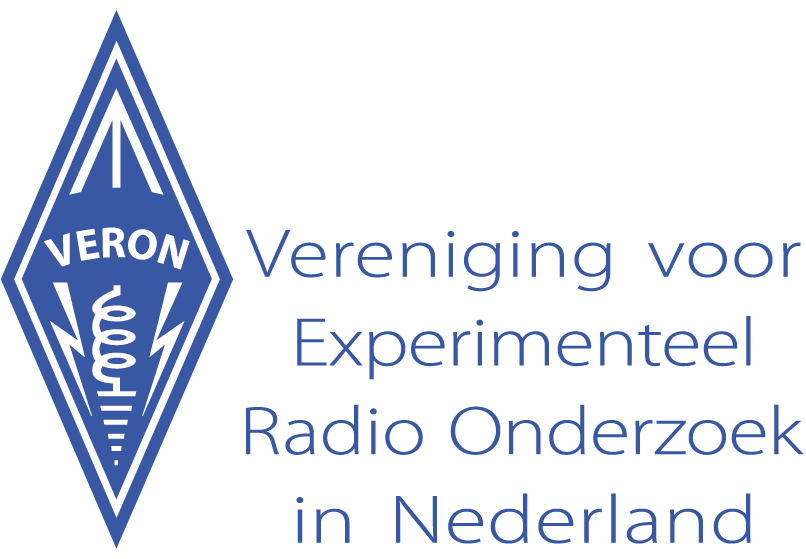
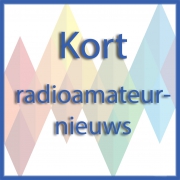 VERON
VERON